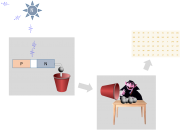Difference between revisions of "Assignment 2 Part 1: Noise in images"
Juliesutton (Talk | contribs) (→Modeling photon emission) |
MAXINE JONAS (Talk | contribs) m (→Overview) |
||
| Line 8: | Line 8: | ||
Acquiring a digital image is essentially an exercise in measuring the intensity of light at numerous points on a grid. Light intensity measurements are subject to noise sources that limit the precision of images. In other words, when you try to measure how intense a light is, there will in general be a difference between the value that you measure and the true value of the light intensity. The difference between the measure value and the actual value quantities is called ''measurement error''. Mathematically, measurement error can be modeled as a simple difference: <math>M=Q+\epsilon</math>, where <math>M</math> is the measured value, <math>Q</math> is the true (unknowable) value of the quantity (light intensity in this case), and <math>\epsilon</math> is the measurement error. In this part of the assignment, you will develop a software model for the noise sources in a digital image and you will use it to explore how noise impacts digital images. | Acquiring a digital image is essentially an exercise in measuring the intensity of light at numerous points on a grid. Light intensity measurements are subject to noise sources that limit the precision of images. In other words, when you try to measure how intense a light is, there will in general be a difference between the value that you measure and the true value of the light intensity. The difference between the measure value and the actual value quantities is called ''measurement error''. Mathematically, measurement error can be modeled as a simple difference: <math>M=Q+\epsilon</math>, where <math>M</math> is the measured value, <math>Q</math> is the true (unknowable) value of the quantity (light intensity in this case), and <math>\epsilon</math> is the measurement error. In this part of the assignment, you will develop a software model for the noise sources in a digital image and you will use it to explore how noise impacts digital images. | ||
| − | It turns out that the quantum nature of light has fundamental implications for the characteristics of noise in images. As such, we will measure light intensity in units of photons per second per area. | + | It turns out that the quantum nature of light has fundamental implications for the characteristics of noise in images. As such, we will measure light intensity in units of photons per second per area. |
The figure on the right depicts a (very) simplified model of digital image acquisition. In the diagram, a luminous source stochastically emits <math>\bar{N}</math> photons per second. A fraction <math>F_O</math> of the emitted photons lands on a semiconductor detector. Incident photons cause little balls (electrons) to fall out of the detector. The balls fall into a red bucket. At regular intervals, the bucket gets dumped out on to a table where the friendly muppet vampire [http://muppet.wikia.com/wiki/Count_von_Count Count von Count] counts them. The process is repeated for each point on a grid. | The figure on the right depicts a (very) simplified model of digital image acquisition. In the diagram, a luminous source stochastically emits <math>\bar{N}</math> photons per second. A fraction <math>F_O</math> of the emitted photons lands on a semiconductor detector. Incident photons cause little balls (electrons) to fall out of the detector. The balls fall into a red bucket. At regular intervals, the bucket gets dumped out on to a table where the friendly muppet vampire [http://muppet.wikia.com/wiki/Count_von_Count Count von Count] counts them. The process is repeated for each point on a grid. | ||
Revision as of 15:35, 14 September 2017
Overview
Acquiring a digital image is essentially an exercise in measuring the intensity of light at numerous points on a grid. Light intensity measurements are subject to noise sources that limit the precision of images. In other words, when you try to measure how intense a light is, there will in general be a difference between the value that you measure and the true value of the light intensity. The difference between the measure value and the actual value quantities is called measurement error. Mathematically, measurement error can be modeled as a simple difference: $ M=Q+\epsilon $, where $ M $ is the measured value, $ Q $ is the true (unknowable) value of the quantity (light intensity in this case), and $ \epsilon $ is the measurement error. In this part of the assignment, you will develop a software model for the noise sources in a digital image and you will use it to explore how noise impacts digital images.
It turns out that the quantum nature of light has fundamental implications for the characteristics of noise in images. As such, we will measure light intensity in units of photons per second per area.
The figure on the right depicts a (very) simplified model of digital image acquisition. In the diagram, a luminous source stochastically emits $ \bar{N} $ photons per second. A fraction $ F_O $ of the emitted photons lands on a semiconductor detector. Incident photons cause little balls (electrons) to fall out of the detector. The balls fall into a red bucket. At regular intervals, the bucket gets dumped out on to a table where the friendly muppet vampire Count von Count counts them. The process is repeated for each point on a grid.
Modeling photon emission
File:PDF of MATLAB rand and randn functions
- Overview
- Part 1: Noise in images
- Part 2: Fluorescence microscopy
- Part 3: Build an epi-illuminator for your microscope
Back to 20.309 Main Page

